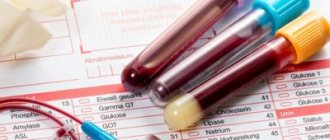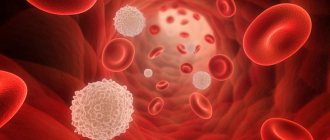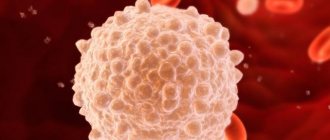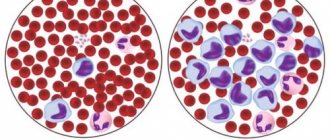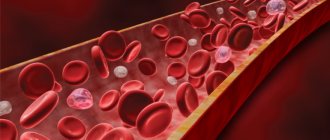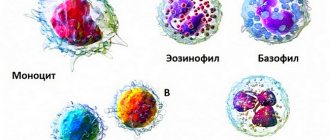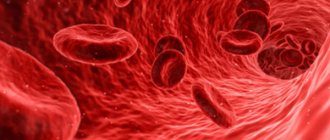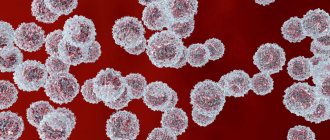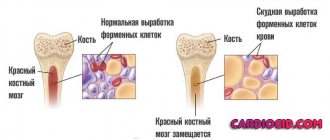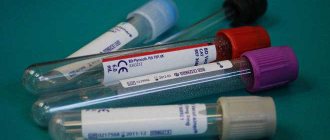Cellular elements of blood (image obtained using a scanning electron microscope). Biconcave red blood cells and spherical white blood cells
with a rough surface
Leukocytes
(from ancient Greek λευκός - white and κύτος - container, body) - white blood cells; a heterogeneous group of human or animal blood cells of different appearance and functions, identified by the presence of a nucleus and the absence of independent coloring.
The main sphere of action of leukocytes is protection. They play a major role in the specific and nonspecific protection of the body from external and internal pathogenic agents, as well as in the implementation of typical pathological processes.
All types of leukocytes are capable of active movement and can pass through the capillary wall and penetrate into the intercellular space, where they absorb and digest foreign particles. This process is called phagocytosis, and the cells that carry it out are phagocytes.
If a lot of foreign bodies have entered the body, then the phagocytes, absorbing them, greatly increase in size and are eventually destroyed. This releases substances that cause a local inflammatory reaction, which is accompanied by swelling, fever and redness of the affected area.
Substances that cause an inflammatory reaction attract new leukocytes to the site of foreign body penetration. By destroying foreign bodies and damaged cells, leukocytes die in large quantities. Pus, which forms in tissues during inflammation, is an accumulation of dead leukocytes.
White blood cell count
The blood of an adult contains 1000 times fewer leukocytes than red blood cells, and on average their number is 4-9 109/. In newborn children, especially in the first days of life, the number of leukocytes can vary greatly from 9 to 30 109/. In children aged 1-3 years, the number of leukocytes in the blood ranges from 6.0-17.0 109/, and in 6-10 years - from 6.0-11.0 109/[1][2] .
The content of leukocytes in the blood is not constant, but changes dynamically depending on the time of day and the functional state of the body. Thus, the number of leukocytes usually increases slightly in the evening, after eating, as well as after physical and emotional stress.
An increase in the total absolute number of leukocytes per unit volume above the upper limit of normal is called absolute leukocytosis
, and its decrease below the lower limit is
absolute leukopenia
.
Leukocytosis
Main article: Leukocytosis
Neutrophil leukocyte engulfing anthrax cells (scanning electron microscope, pseudocolors)
True leukocytosis
occurs when the formation of leukocytes increases and their release from the bone marrow.
If the increase in the content of leukocytes in the blood is associated with the entry into circulation of those cells that are under normal conditions attached to the inner surface of the vessels, such leukocytosis is called redistributive
.
It is the redistribution of leukocytes that explains the fluctuations during the day. Thus, the number of leukocytes usually increases slightly in the evening, as well as after eating.
Physiological leukocytosis
observed in the premenstrual period, in the second half of pregnancy, 1-2 weeks after delivery.
Physiological redistributive leukocytosis can be observed after eating, after physical or emotional stress, exposure to cold or heat.
Leukocytosis as a pathological reaction most often indicates an infectious or aseptic inflammatory process in the body. In addition, leukocytosis is often detected in case of poisoning with nitrobenzene, aniline, in the initial phase of radiation sickness, as a side effect of certain medications, as well as in malignant neoplasms, acute blood loss and many other pathological processes. In its most severe form, leukocytosis occurs in leukemia.
Leukopenia
Main article: Leukopenia
Leukopenia can also be physiological (constitutional leukopenia) and pathological, redistributive and true.
Some causes of leukopenia:
- chronic infections: tuberculosis, HIV;
- hypersplenism syndrome;
- lymphogranulomatosis;
- aplastic bone marrow conditions;
- stress.
What are they needed for?
Before finding out where leukocytes are formed in humans, you should understand the essence of the phenomenon: what kind of cells are designated by this name? Doctors say that this blood element is one of the most important, as it forms a barrier that can protect the body from the negative influence of external factors affecting the circulatory system. If a person falls ill, he is immediately given a referral for a blood test to determine the level of leukocytes - this information will allow him to get a complete picture of what is happening in the body.
White blood cells (leukocytes) allow you to make a preliminary diagnosis quite accurately, as well as determine what additional studies are required. If the number of cells is abnormal, there is likely a serious illness. Since the doctor knows where leukocytes are formed and how long they live, based on the concentration of these elements of the circulatory system, he can tell whether the disease is beginning or whether an active stage is now observed. The doctor will explain in detail what to do to defeat the pathology.
Types of leukocytes
Leukocytes is a collective concept introduced in the 19th century and retained for the sake of simplicity in contrasting “white blood - red blood”. According to modern data, leukocytes differ in origin, function and appearance. Some leukocytes are able to capture and digest foreign microorganisms (phagocytosis), while others can produce antibodies. As a result, there are several types of leukocyte division, the simplest of which is based on the presence/absence of specific granules in their cytoplasm. Based on morphological characteristics, leukocytes stained according to Romanovsky-Giemsa have been traditionally divided into two groups since the time of Ehrlich:
- granular leukocytes, or granulocytes
- cells that have large segmented nuclei and exhibit a specific granularity of the cytoplasm; depending on the ability to perceive dyes, they are divided into neutrophilic, eosinophilic and basophilic; - non-granular leukocytes, or agranulocytes
, are cells that do not have a specific granularity and contain a simple non-segmented nucleus, these include lymphocytes and monocytes.
The ratio of different types of white cells, expressed as a percentage, is called the leukocyte formula.
The study of the number and ratio of leukocytes is an important step in the diagnosis of diseases.
Eosinophils are leukocytes containing a bilobed nucleus and granules that stain red with eosin. They regulate allergic reactions, their number increases with allergies, as well as in cases of infection with parasitic worms (helminths).
The most interesting thing: where are they formed?
Red blood cells, white blood cells and platelets are important elements formed by the hematopoietic system. Disturbances in its activity are considered very serious, life-threatening problems for the patient. It’s not surprising, because blood cells form vital organs:
- Bone marrow;
- tonsils;
- The lymph nodes;
- spleen.
Leukocytes themselves can produce active compounds - antibodies that can fight inflammatory mediators. The process of the appearance of cells in medicine is called leukopoiesis. The largest percentage is formed in the bone marrow. The lifespan of a leukocyte is up to 12 days.
Types
Determining the size of each type of white blood cell allows you to more accurately determine the causes of the disease, since each type of cell performs a specific function:
- neutrophils carry out phagocytosis of relatively small particles. After their death, cells release a significant amount of biologically active substances, enhancing the response of the immune system;
- lymphocytes are capable of synthesizing antibodies that neutralize pathogens and their toxins. In addition, they control the functioning of other cells of the immune system;
- Monocytes destroy large numbers of small foreign bodies or large pathogens using phagocytosis. A distinctive characteristic is the ability to perform a protective function even at acidic pH values, when neutrophils lose their antimicrobial activity;
- eosinophils implement antiparasitic defense of the human body, and also take a major part in the development of an allergic reaction;
- basophils promote the influx of white blood cells into the site of inflammation through their own degranulation, which results in the release of a large number of mediators of allergy and inflammation.
Read further: Eosinophil cationic protein - what it shows and what to do if it is elevated in a child
What is highlighted?
There are granular leukocytes (where they are formed, doctors established quite a long time ago - in the bone marrow) - these are called granulocytes. The name is due to the structural feature of the cytoplasm. The second group is agranulocytes, that is, not granular. Such cells are formed in the bone marrow and in other organs listed above - the spleen, the lymphatic system.
Granulocytes last up to 30 hours, but agranulocytes last up to three weeks (but not less than 40 hours in a healthy person). The division into these groups simplifies the diagnosis based on laboratory tests.
Features of the analysis
It is necessary to pay attention to the activity of the organs where leukocytes are formed if, based on the results of a correctly conducted study, the indicators were outside normal limits. But what does “correct” mean? To understand this, it is worth understanding the procedure itself.
First, acetic acid is poured into the test tube, the color of which is changed due to methylene blue. A drop of the patient’s blood is dropped into the reagent and mixed thoroughly, the chamber and glass are wiped with clean gauze, the glass is rubbed against the chamber and wait for the formation of multi-colored rings. The chamber is filled with plasma. Waiting time is one minute. After this period, the cells stop moving. The laboratory technician uses a special formula to accurately calculate the indicators.
Neutrophils
From half to 70% of the total mass of leukocytes is composed of this particular category of cells. They are produced by the bone marrow and belong to the class of phagocytes. There are two types of molecules: with a rod-shaped core (immature) and mature - segmented. Most of the blood contains mature cells of this class, least of all young ones. By identifying the ratio of the number of these groups, the intensity of hematopoiesis can be assessed. With significant blood loss, the cells do not get the opportunity to mature, then the ratio changes in favor of young compounds.
Blood concentration
Knowing where red blood cells and white blood cells are formed, you can look at the known parameters of the concentration of blood elements - what is normal and what should cause concern. To identify specific indicators, the doctor issues a referral for a general analysis. The number of leukocytes is measured at a concentration of 10^9/l. With results of 4.2-10*10^9/l there is nothing to worry about; such values are considered normal for adults. In childhood, the norm is 5.5-15.5*10^9/l. Based on the information obtained by the laboratory technicians, the doctor will also determine how the different fractions of these cells relate to each other.
If the indicator turns out to be outside the norm, this does not mean that the activity of the organ where leukocytes are formed is impaired. The probability of an erroneous result is no less high: for example, there could be a failure in the laboratory that caused an incorrect result. If leukocytopenia or leukocytosis is suspected, a comprehensive study must be done. Only if all its stages confirm the preliminary diagnosis, treatment begins. First, the patient will be sent for a repeat general analysis, and then the doctor will make a decision based on the results. In some cases, based on these data, it is possible to select a course of treatment.
What to pay attention to
One of the important functions of leukocytes is synthetic. This means that it is through such blood cells that the formation of some components necessary for the normal functioning of the human body occurs. We are talking about histamine, heparin.
There are several types of leukocytes in the human body. Each of them has specific functions and structural features. The division into groups is based not only on the duration of the existence of cells, but also on the organs producing a particular type.
